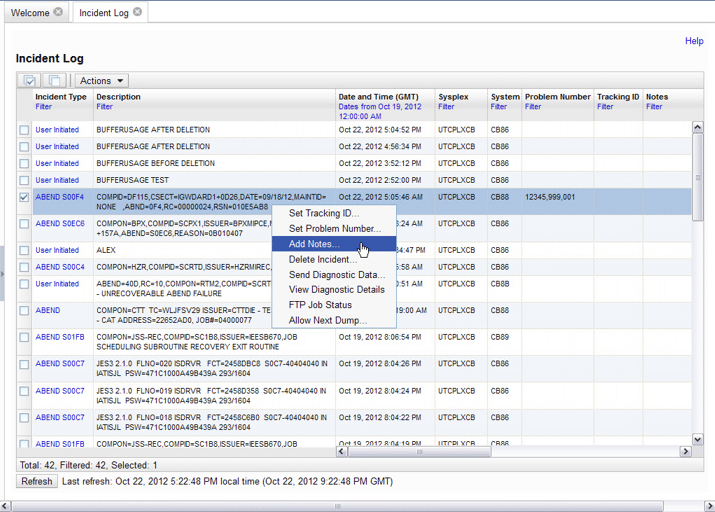Incident Log task overview
When a problem occurs on a z/OS® system, you might need to determine what happened and why, and then find the fix or report the problem to IBM® or an independent software vendor (ISV). Typically, you need to get to the root of the problem quickly, but the task of gathering diagnostic data and sending it to a support team can be very time-consuming. To assist you with diagnosing and reporting the problem, z/OSMF offers a problem data management solution, the Incident Log task.
The Incident Log task streamlines and automates time-consuming and manual parts of the problem data management process. Specifically, the Incident Log task gathers and displays system-detected and user-initiated incidents, collects associated logs and dumps at the time of the problem, and facilitates sending that data to IBM or another vendor for further diagnostics. Using the Incident Log task reduces the possibility of errors while obtaining, aggregating and sending the collection of diagnostic data to IBM or an ISV.
To open the Incident Log task, in the navigation area, expand the Problem Determination category and select Incident Log. The Incident Log page is displayed.
Figure 1 shows a sample view from the Incident Log task.

Key features
With the Incident Log task, you can:
Manage the incidents that occurred on a system or in a sysplex. The Incident Log task provides a consolidated view of all incidents occurring on all participating systems in the sysplex (those that communicate through the same sysplex dump directory).
Browse the logs collected for an incident. When an incident occurs, the Incident Log task collects and saves the associated SVC dumps and diagnostic log snapshots. You can browse the error log, error log summary, and operations log.
Allow the next dump of an incident with the same MVS™ symptom string. The Incident Log task provides the ability to update the DAE data set, so that you can capture the next instance of an SVC dump being suppressed by DAE.
Send diagnostic data and attachments to IBM or another vendor for further diagnostics. The Incident Log task provides a wizard that you can use to send diagnostic data and additional attachments to IBM or another vendor. You can send files using standard FTP or SFTP, or using the z/OS Problem Documentation Upload Utility (PDUU), which supports parallel FTP and encryption. For more information about PDUU, see z/OS MVS Diagnosis: Tools and Service Aids.
Associate the incident with problems recorded in other problem management systems. The Incident Log task allows you to correlate an incident with an IBM problem number, an ISV problem number, or with a problem record in your installation's problem management system.
Track additional information with an incident. The Incident Log task allows you to specify additional information that you want to track about an incident, such as who is assigned to resolve the issue, which business applications are impacted, which component is the source of the issue, and which solution has been implemented.
Monitor the status of an FTP or SFTP job. An FTP or SFTP job is created when you send diagnostic data to IBM or another vendor. The Incident Log task allows you to browse or cancel these jobs and view or delete the status of these jobs.
For information about using this task, see the online help.